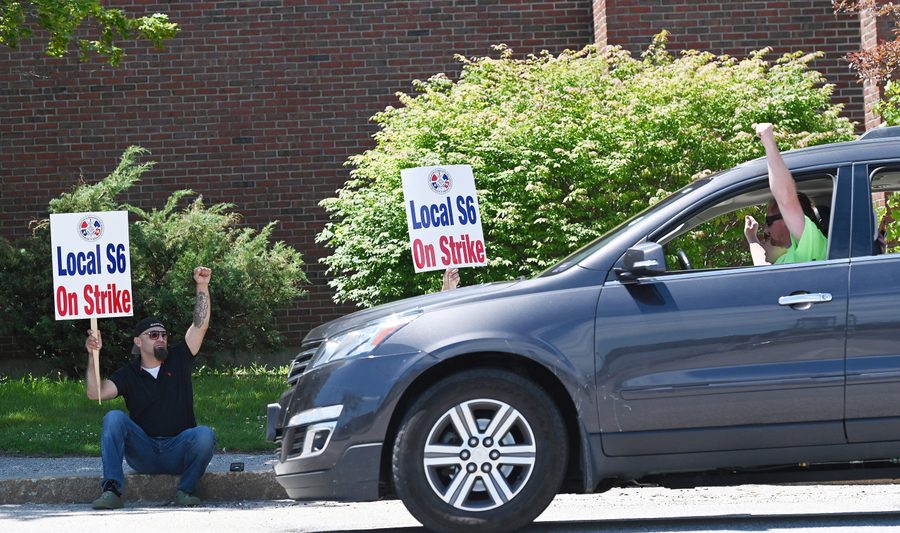The Largest Private-Sector Strike of the Year Is Headed for Union Victory
After nearly seven weeks on the picket line, Machinists union members will soon vote on a contract that includes everything they’re fighting for.
Jeremy Gantz

BATH, MAINE — It’s no coincidence that the first strike in 20 years at Bath Iron Works (BIW) began months into the Covid-19 pandemic. While Maine has one of the lowest Covid transmission rates in the country, the spread of the deadly virus helped spark the strike that has largely shut down the shipyard at BIW — one of Maine’s largest employers.
In June, when around 4,300 Machinists Local S6 union members at BIW voted overwhelmingly to strike, many had already soured on management over its handling of the pandemic.
The walkout — which represents the largest private-sector strike of the year — has lasted for nearly seven weeks. But late last week, both sides saw a breakthrough as a tentative agreement was reached that appears to hand the union a victory on its demands.
BIW, a General Dynamics subsidiary that builds battleships for the U.S. Navy, never shut down the production facility because it was deemed an “essential business” by the U.S. government. After a BIW worker tested positive for the virus in late March, the company encouraged employees not to report to work. Many did stay home for weeks — but they had to use paid vacation or sick time, or work unpaid. Union leaders called for a shutdown with pay while also pushing state lawmakers to pressure the Navy to allow the shipyard to close.
“They said we’re essential workers because we build battleships, but how essential are you if you get sick? It’s scary for a lot of people,” said John Louis Cabral III, a shipyard worker and Local S6 member.
Cabral, 34, couldn’t afford to stay home long: He was hired last year and had little accrued paid time off. With three kids to support and no access to pandemic-related unemployment benefits since he wasn’t furloughed, he went back to the yard.
With employee attendance way below normal for weeks, BIW fell further behind on production of Navy guided-missile destroyers. As part of negotiations with Local S6 for a new three-year contract, the company proposed changes allowing it to hire nonunion subcontractors more quickly. That and other proposed changes to seniority and work rules in the company’s “last, best, and final offer” on June 13 did not go over well with Local S6.
“It’s a power struggle in the yard right now, and that’s facts,” said Cabral, who helps manage inventory at the shipyard.
On June 22, 87% of Local S6 members voted in favor of striking, even though they’d lose company-paid health insurance during a pandemic. Federal mediators were brought in to restart negotiations in July, around the same time BIW laid off members of another union local and brought in subcontractors from out of state to avoid falling further behind on production.
“We’re all standing as one because we don’t want subcontracting in here,” Chad Bamford, a 25-year-old crane rigger who’s worked at BIW since 2017, said on the picket line Friday. “They’re trying to subcontract out our work. We don’t want outsiders. Give us more overtime. We build the best ships in the world.”
The company has said it never wanted to permanently outsource work away from the union through subcontractors. “We seek only efficient access to all available resources to improve our ability to deliver to the US Navy on time,” BIW President Dirk Lesko wrote
in June. The shipyard was six months behind schedule at the start of the strike.
Both Bamford and Cabral blame production delays on both the pandemic and mismanagement. A BIW spokesperson did not respond to a request for comment.
Union victory in hand?
After weeks of meetings that yielded little, union and BIW negotiators broke through to an agreement Friday, and it looks like the union got everything it wanted.
In a tentative agreement announced Saturday, Local S6 leaders trumpeted the retention of status quo contract language on subcontractors and seniority and work rules. The agreement also retains 3% annual raises for workers. A “temporary catchup phase” will allow expanded subcontracting through the end of this year, and a joint union-company committee will begin meeting weekly to ensure schedule gains.
The deal, unanimously approved by the union negotiating committee, “preserves our subcontracting process, protects seniority provisions and calls for a collaborative effort to get back on schedule,” Local S6 leader Jay Wadleigh told the Associated Press Saturday. The agreement also includes healthcare benefit gains.
“We are pleased to have reached agreement with our union partners and look forward to getting back to the job of building ships for the U.S. Navy,” Phebe Novakovic, chairman and CEO of General Dynamics, said in a statement the same day.
Local S6 members will vote to ratify the proposed contract online and via phone later this month. If it’s approved — which both Cabral and Bamford believe is likely — the lack of concessions will stand in contrast to the last contract. Back in 2015, workers narrowly voted to give up scheduled raises in favor of one-time bonuses to protect jobs and help BIW win a new U.S. Coast Guard contract (though the company ended up losing that contract to a competitor).
General Dynamics, one of the largest defense contractors in the country, made $3.5 billion in profits last year. In 2018, tax cuts backed by the Trump administration helped cut the Fortune 500 company’s effective tax rate almost in half, according to Labor Notes. That same year, the Maine legislature handed BIW a $45 million tax break.
Bamford said he knows some people don’t agree with unions — but the strike has only deepened his pride in Local S6 and what it can achieve. The tentative agreement, he said, sounds like a “big win.”
“Until you’ve been a part of a union and you have 4,300 people standing with you as one for one cause, it’s a feeling you can’t describe,” Bamford said. “It makes you proud to be with it.”
Cabral agrees: “Solidarity is awesome. The strike has built camaraderie.”
Jeremy Gantz is an In These Times contributing editor working at Time magazine.








